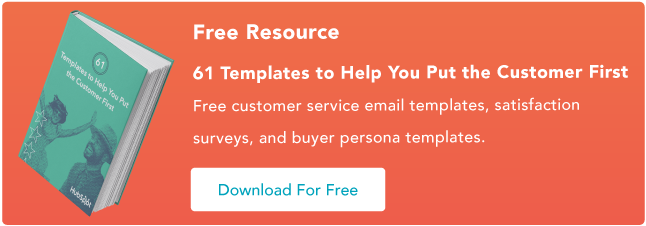You love your customers -- and for good reason.

They keep the lights on after all, and you worked hard to get them. But keeping them happy isn’t easy, and if it seems like it’s getting harder, you’re right.
Customers across all industries are asking more questions, demanding more of your time, and leaving for competition more often. Why?
The last five years have brought massive change to the customer-business relationship. Today, customers have more options than ever, more information, and month-to-month subscription models have made it easy for them to switch vendors if they aren’t happy. They now have all the power, and as a result, they're demanding an entirely new level of service.![→ Free Download: 61 Templates to Help You Put the Customer First [Download Now]](https://no-cache.hubspot.com/cta/default/53/a66c79d4-2a39-46e6-a80a-f7b999133c06.png)
They want help on their terms, not yours -- and they’ll leave if they don’t get it. The typical customer service playbook doesn’t take this shift into account, and that’s why most companies fail to impress the folks who pay them.
But increasing customer retention rates by as little as 5% can increase profits by 25% to 95%, and Gallup says B2B customers with high customer engagement scores achieve 50% higher sales revenues and 34% higher profitability than other companies. So it's up to customer service leaders to adapt their strategies to keep customers happy and successful -- because that makes the company successful, too.

Customer Success Model
A customer success model outlines how a company will engage with a consumer throughout their customer journey. It accounts for both reactive and proactive functions performed by service and support teams, ensuring customers get the most from the product or service. If executed properly, these initiatives reduce churn rates and create opportunities for upselling and cross-selling.
Currently, most customer success models look like this:
- Buy a complex piece of ticketing software.
- Push customers to request help through a singular channel -- like a web form.
- Create a queue of issues and cases.
- Hire cheap labor to work through the tickets fast.
- Scale as much of this work as possible to reduce cost.
This focuses on speed and efficiency, not the customer's needs and goals. Rather than trying to help you achieve success, these service teams just want to solve your case and move on to the next customer.
This approach was built for a world where the business is in control, not the customer. It’s all about the process, and not about the people being served. We’ve all felt the pain of being part of some business’s process: waiting on hold, getting assigned a ticket number, retelling person after person your information and issue. It sucks.

What's missing is an investment in customer success. If businesses structured their services around the customer rather than their own convenience, they’d dramatically increase customer satisfaction and reduce churn rates. Customers would be happy because the company is helping them achieve their goals instead of being a roadblock to their success.
Customer success fosters long-term achievement as well. Since it’s a proactive service, support teams are actively looking for ways to help customers both now and in the future. If they spot a potential roadblock, they can alert the customer and reach out with a solution. That not only builds trust with your customer base but it also grows customer lifetime value over time.
Additionally, customer success not only helps customers' achieve but businesses as well. In fact, research shows that growing companies are 21% more likely than stagnant businesses to value customer success as "very important." We can review the data in the chart below. 
Why Customer Success Is Important For SMBs
Customers deserve better, and the fun part is, once you’re able to truly help them, happy customers can grow your business faster than sales and marketing.
That’s right -- you can flip the idea of customer service being a cost center and turn it into a source of revenue and valuable insights.
This isn’t a trick -- happy customers buy more, pay more, refer their friends, forgive you when things break, volunteer for case studies, and help you promote new features.
Some of the world's most empathetic companies -- like Amazon, Virgin, Apple, and the Walt Disney Company -- all celebrate customers, and all have experienced massive growth in the last several years. For example, Amazon CEO Jeff Bezos believes in "obsessing over customers" instead of worrying about what competitors are doing, which helped Amazon listen to feedback and develop new services and offerings that drive billions of dollars in revenue.
Customers are your most undervalued growth asset, and it’s time we invest in them. But to get there, we need to act less like the DMV, and more like a helpful friend. This is easier said than done, but we think the right technology and playbook can help you do this -- without costs ballooning. In fact, you'll most likely retain more customers, which cost less than acquiring new ones, and they'll stay with you longer, delivering more revenue.

Customer Success Best Practices
- Rally everyone around the customer.
- Help your customers how they want to be helped.
- Solve for short- and long-term needs.
- Take time to understand customers.
- Provide personalized solutions.
- Hire the right amount of staff.
1. Rally everyone around the customer.
Having one person or team responsible for all customer needs is unreasonable and isolates customers and data into silos. Customer success should be a team sport.
You’ll still want one person running point, acting as the captain and coordinator, but it’s critical for everyone to work with customers. For many customer service professionals, their job is to understand customers, then find the right information -- perhaps from a Product Manager or Designer -- to relay back to the customer.
But why not have the Customer Success Manager (CSM) bring the Product Manager (PM) directly into the customer conversation? At a big company, this doesn’t scale, but at a smaller one, the information a PM can capture directly from the customer is invaluable. A PM who doesn’t want to talk to customers about their problems is a bad PM -- help them have these conversations.
With the right system, this interaction can be quick, valuable, and well organized. Most importantly, it’ll mean customers get the best answer faster. Companies can institute weekly reporting and monthly meetings to keep the team informed on customer feedback, or every employee can take over responding to a set number of inquiries per week -- making everyone more empathetic and more informed about the customer.
The CSM is still the person managing the back-and-forth, but this approach allows your whole team to rally around the customer, and become more driven by what they need. It shares information and helps everyone.
2. Help your customers how they want to be helped.
Customers don’t want to waste time. When they need help, they want to get it in the easiest and fastest form. Maybe this means a phone call during business hours, but it may also mean an easy-to-find support article, a series of quick emails, or a Facebook message.
In a forthcoming survey of more than 1,000 global customers, we found that 60% of people preferred to use phone and email for customer support. On the other hand, only 26% of customers liked submitting a form on a website -- but more than half of companies offered that as an option.
Remember -- customers are in charge now, and they don't want to spend all day waiting on hold or filling out a form. And, if you're unable to deliver on basic service promises, customers are more likely to consider other options. So, make it as simple and easy as possible for customers to reach out for prompt problem-solving.
The point is to stop funneling people into your system and instead, take a more flexible approach. Build a knowledge base to help people with do-it-yourself support and embrace any channel that questions come in from. You know your customers best, so figure out what makes the most sense for them. Slack, website widgets, Facebook Messenger, email, chat, and Twitter are all channels that make it easier for customers to quickly ask questions -- so embrace them.
It’ll take time to adapt to those channels, but you’ll start seeing messages from folks that you’ve never seen before. It’s amazing what kind of information people will share if you make it easy for them, so encourage the conversation.
3. Solve for short- and long-term needs.
When a customer calls or writes, they usually need help with a specific issue. It’s important to solve that problem and solve it well. But it’s also an opportunity to identify any bigger issues or opportunities you see for that customer.
If someone reaches out and you solve their specific issue -- and also point out an opportunity they are missing out on -- you've just completely flipped an upset customer into a happy one. You can’t do that if you spend half the time you have with them getting their account number, rehashing their issue, trying to find someone who can help, and checking off the boxes along your internal process.
You need to invest the time in a system that gives you the information you need about a customer before they reach out. That way, when they do reach out, you can take a few minutes and understand exactly who they are and what you can do to help them. Let customers know you can take as much time as they need, and that you actually want to learn more about their business, their issues, and who they are, and you’ll have much more valuable conversations with them.
If you're a growing customer success team that's trying to scale, you might be wondering how slowing down to spend so much time on customers will benefit you. But remember, the time you spend on customers will pay off -- because customer success is a revenue generator, not a cost center. Retaining customers costs less than acquiring new ones, satisfied customers buy more often and spend more, and happy customers tell their friends and bring in new leads, completely free of charge.
4. Take time to understand customers.
Customers can be your biggest fans or your worst detractors, and it shouldn’t be a mystery which bucket they fall into.
It’s good to speak with folks individually to dive deep on big issues, but implementing a system that tracks this sentiment at scale is the best way to turn customer success into a growth engine.
Net Promoter Score® (NPS) can be implemented as part of every customer conversation, and it’ll quickly give you a data-driven pulse on customer happiness. If you’re categorizing conversations, it’ll also tell you which issues are associated with the most unhappy customers.
This data is pure gold. It should inform long-term product decisions, but also shorter-term customer service and marketing efforts. If someone is upset, address them, and figure out why. That alone may be enough to keep them from switching. And if it isn’t, you just gained valuable insight for the future. With customers in control, you can no longer afford to not know why a person decided to leave you as a customer.
5. Provide personalized solutions.
Not every customer is the same, so not every solution is one-size-fits-all. Personalizing your customer service efforts to match the needs of individual customers is a great way to build rapport with them. This makes them feel less like another number on your sales sheet and more like a valued member of your organization’s community.
This is where a CRM comes in handy. A CRM is a tool that records customer data and stores it in an easy-to-access, centralized location. With this software, every employee can record customer engagements and store information for later use. Customer success teams can then review that data and use it to create unique solutions.
The retail brand, Zappos, is excellent at personalizing its customer service. It’s well known for creating memorable experiences by providing above-and-beyond solutions.
For example, one Zappos customer purchased six pairs of shoes. Since she had a medical issue, none of the shoes would fit and had to return them. After explaining the situation, Zappos sent her a bouquet and gave her entire family VIP status, giving them free shipping and returns on all orders.
Zappos could have just approved the return and the customer probably would have been satisfied. But instead, the service team capitalized on an opportunity to provide more value which gained four more customers for the business.
6. Hire the right amount of staff.
As your company grows, so will your customer base. You'll have more users to work with, placing more stress on your customer success team. In this stage, it's important that staffing doesn't impede or plateau growth. Even if your company is getting bigger you still need to provide customers with that same personalized style of service.
A good rule of thumb is the "rule of 40." This rule states that SaaS companies shouldn't assign more than 40 customers to an individual customer success rep. If you do, you'll probably overwhelm your employee, resulting in frustrated customers or potentially churn.
If your customer demand is rising but you can't hire more reps, consider adopting customer service tools. Automation like chatbots and AI can streamline customer success functions, making it easier for your team to handle multiple tasks at once. This way, you can expand the bandwidth of your customer success team without bringing on new employees.
Customers are in control. It’s already happened. If your industry hasn’t felt it yet, it soon will.
Customers are in control. It’s already happened. If your industry hasn’t felt it yet, it soon will. There are subscriptions for just about everything these days, and more options in every industry. Just like all change, there is and opportunity in this shift.
If you deliver an amazing experience for the people you call customers and follow some of the steps above, you’ll beat the competition and grow like hell.
Simply put, when your customer succeeds, you succeed. It’s time to focus as much energy on customers as we do on sales prospects and marketing leads.
Net Promoter, Net Promoter System, Net Promoter Score, NPS and the NPS-related emoticons are registered trademarks of Bain & Company, Inc., Fred Reichheld and Satmetrix Systems, Inc.










